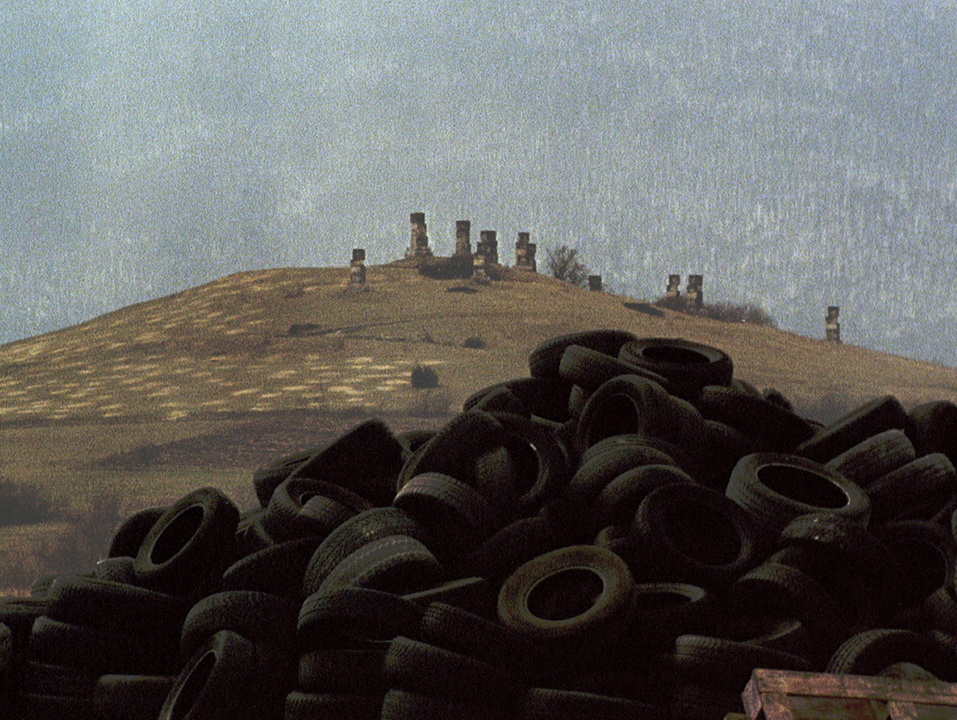In Garavice, a few kilometers outside Bihać in north Bosnia-Herzegovina 12.000 ethnic Serbs, Jews and Roma were killed by the Ustaše regime in the summer of 1941. After the invasion of the Kingdom of Yugoslavia by the Axis powers earlier that year, the puppet state of the Independent State of Croatia was founded, which adopted the racist ideology of Nazi Germany against Jews and primarily Serbs. Forty years later a memorial park commemorating the victims of the massacre was erected at the extermination location. It had been designed by architect Bogdan Bogdanović who was forced into self-imposed exile in 1993.
In March 2015 I was filming a pile of tires in the backyard of a car service station in the town of Bihać. For someone growing up in Cyprus truck tires are always subconsciously related to a borderline, a buffer zone. The sky was overcast, and some rubbish was burning on the bordering plot. As the wind was blowing from the north the smoke was carried through the frame. Shortly afterwards the sky cleared and the Garavice memorial was rendered visible. The erratic rays of sunshine gave the background a two-dimensional aspect, transforming it into a backdrop, as it were. It was only weeks afterwards that I had the processed film in my hands and its images on screen. The tires, the smoke, the dotted light like paint dabbed onto the hill, the stone blocks: all these elements came unintentionally together to create a scene that viewers of the film would later call evocative. True, maybe, but evocative of what?
From 1992-1995 Bihać was again the site of severe war crimes and atrocities. The town turned into an enclave that was under a three-year siege; surrounded on the west by the secessionist Serb Republic of Serbian Krajina and on the east by the proclaimed Republika Srpska, both cooperating in order to capture the Bosniak population living in or having been displaced to the region since the outbreak of the war. Forms of displacement that have inscribed themselves in physical space demonstrate one thing, after all: the growing incompatibilities in contemporary life. In Days In Between the narrator ruminates on this:
I have the feeling that I am stepping into Zeno’s ‘Achilles and the Tortoise’ paradox – moving, yet motionless, always a step behind in my attempt to comprehend. Is plurality and change an illusion? I begin to ponder asynchronicity and different speeds, that of the traveling observer and that of the protagonists between the takes, who in turn have their own tempi. I am reminded of Amel, who lives in a brick hut in Bosnia with his small family. ‘There is no work here,’ he says, ‘if the system doesn’t take you in, take another path.’ He tried it in Qatar, his body couldn’t cope with the heat. To begin all over again, continually – is that the characteristic feature of the whole region?
It is the 1st of August 2019 and I’m flying from Berlin to Cyprus. I read an article about the cumbersome situation along the ‘Balkan route’. Bihać is once more the center of attention, the place where all routes end. Five thousand refugees are now stranded in the town, the same number as there were casualties during the Bihać siege 1992-1995. One of the biggest camps has been recently relocated outside the city to a former garbage dump, one kilometer away from a minefield laid during the Yugoslav wars - not far from where we met Amel the first time. The river Korana separating Croatia and Bosnia-Herzegovina performs anew as a hazardous frontier that has to be crossed in what the refugees call “the game” - the river’s durability as a border put again to the test. Tragically, losing the game means momentarily becoming a subject of history. The commentary in the film recounts:
He wrote me, ‘There are rivers here like the Drina that don’t tell you what their accorded role is, that for the past two thousand years, they’ve so often had to perform as the frontier between two ostensibly so different worlds. For centuries constructs of that kind fall into oblivion, only to be reactivated for a short interim.’
The still shot in Bihać in 2015 could be imagined as a photographic wallpaper, in front of which every one of us can take his/her picture, a memento of our share in inequity—to yield to a shared sense of vulnerability.
Before boarding that same plane mentioned above I was halted at the baggage control of the Tegel airport. The x-ray device had mistakenly detected a piece of gammon in my cabin baggage. Whilst searching my stuff the eyes of the elderly inspector fell upon the title of the book I was carrying: BALKAN as Metaphor. He looked up at me and reluctantly asked in broken German: “Are you from Serbia?” In the book I read Vesna Goldsworthy’s essay where she notes: “In academic debates, the “politically correct” term Southeastern Europe has more or less replaced the Balkans, because it has become impossible to define a country as “Balkan” without having to explain oneself. Indeed Serbia under Slobodan Milošević seems to be the last country in the peninsula that is regularly described as Balkan, with obvious symbolic connotations.”1 Trinh T. Minh-ha urges us to reappropriate downgrading terms, re-politicizing them through this gesture and turning their negative connotation to our advantage.2 In this stream of thought Days In Between is a tributary of artistic research into the multiple, complex and ever-surprising possibilities of a material reading through the Balkans.

